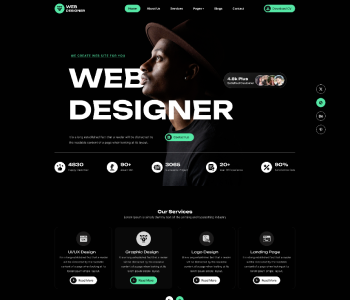Introduction:
It is imperative that you give thoughtful consideration to the styling of any content you work on. Will it have a fragile cursive font or be aggressive and modern? Is it slender and fragile or big and strong? It's critical to select fonts carefully, given that they greatly impact readability, branding, and aesthetics in any design setting. We've broken down every necessary detail for you to fully comprehend the wonderful world of fonts in this guide.
What does a font mean:
A typeface is an assortment of characters with a uniform visual language. In the larger field of typography, fonts are of the utmost importance because they influence the size, weight, and style of all the text you use in a design project. Selecting suitable fonts is crucial since it affects both readability and overall appearance.
A Simple Guide to Selecting the Ideal Font for Your Site:
The process of creating a website is complex and vital, involving several minute elements. Everything from logo placement and padding to social media channel alignment can have an important effect on how well your web page performs overall.
The capacity to organise all of these elements in an orderly and well-balanced order is what sets an interesting and successful website apart from a poor and amateur one.
The style of font that you choose for your website is one of the most important—yet subtle—differentiators in this context.
Your website's typeface conveys a lot about you to your audience; therefore, it's important to use it well to tie other design aspects together if you want people to read your material.
What is a font family?
A family of fonts is a collection of typefaces with a common design element. You have a unified visual identity with various stylistic variations (font styles) within a font family. For example, there are numerous alternative styles available in the Legend font family: thin, extra light, light, typical, medium, semi-bold, bold, extra bold, and black.
Which font type is best:
There are a lot of great font designs available that may communicate ideas in many ways. However, overall, the present group of typefaces may be divided into the following six classes:.
- Black lettering fonts
- Display fonts
- Handwriting fonts
- Sans-serif fonts
- Serif fonts
- Slab-serif fonts
Let's dive into a more thorough explanation of each type so that we can better comprehend the way they need to be utilised.
Think about employing one of the black letter font families when you want to create a classic and gothic look. This strong and challenging typeface style usually appears in old book editions.
It goes beyond saying that this is inappropriate for text bodies; however, we can use them for making distinctions in headings and brief sentences.
Display typefaces are attractive and distinctive; they are frequently referred to as colourful fonts. They usually serve the purpose of brief text bursts that ought to stick out and have an impact, like headlines, titles, and logos. This group includes the font families Playfair Display, Lobster, and Bebas Neue.
Fonts that replicate handwriting are called handwritten fonts. Their styles vary from calligraphic, humorous, and artistic to vintage and retro. Font families that are handwritten include Quicksand, Dancing Script, and Comic Sans.
Sans-serif fonts lack the extra strokes or flicks at the very end of letterforms, in contrast with serif fonts. Sans-serif typefaces are usually bold, modern, and easy to read. Sans-serif fonts come in a variety of forms, which we are about to talk about.
Sans-serif geometric fonts. Made of geometrical shapes and patterns. Known for their consistent stroke lengths and contemporary, minimalist design, The geometric sans-serif family of fonts, Futura and Avenir, are two examples.
Humanist sans-serif fonts. Moved by Roman script typography. Distinguished by their varied stroke widths as well as asymmetrical letter shapes
Tahoma, Optima, and Gill Sans Grotesque sans-serif fonts are a few families of humanist sans-serif typefaces. A classic sans-serif font type from the beginning. Typically, they have a constant stroke width and a geometric pattern.
The Franklin Gothic and Akzidenz-Grotesk font collections are two instances of hideous sans-serif font families. Neo-grotesque sans-serif fonts. An enhanced take on the grotesque font style. Balanced proportions and a cleaner appearance. Families of fonts that are neo-grotesque include Roboto, Arial, and Helvetica.
Small decorative strokes and lines (known as serifs) at the very end of some characters are what differentiate serif typefaces. Based on their design elements, serif fonts may be divided into several styles. Here are a few typical serif font types and a primer on how to tell them apart.
Traditional serif typefaces and those from the past. Distinguished by diagonal, left-leaning stress in round letters. Reduced contrast between strokes that are thick and thin. Font families with old-style serifs include Caslon, Bembo, and Garamond.
Modern serif fonts are acknowledged for having a greater contrast among thick and thin lines. In rounded letters, the vertical stress. Families that comprise modern serif fonts include Didot and Bodoni.
Transitional serif fonts: a link between serif fonts from past centuries and the present. The ratio of thick to thin strokes is moderate. Have a higher vertical axis and stronger serifs than older-style fonts. Times New Roman and Baskerville are two families of classic serif fonts.
This font family's serifs and edges are thicker and wider compared to those of the previous style. They are therefore more difficult to read and a poor choice for longer text passages.
As an alternative, we may use them to differentiate them from the other sections by using them as titles and brief statements.
How do I choose the best font for a website:
Make note of the licences that restrict the use of particular typefaces before delving into the various factors.
Even if you can use most of the available fonts for free, make sure you check the restrictions before using any particular font family.
You are able to utilise the Google font library to obtain free fonts, and you can pay an annual fee to access the Adobe and Envato Elements font collections.
In this way, you may be sure that the typeface you select has the approval of typographers globally.
Clearly define your tone:
On the internet, the typeface you choose symbolises your company and brand. It might be extremely challenging to decide which font should be used in the beginning. As a result, you ought to start with the fundamentals.
In general, potential brand tones can be categorised as moderate and conservative, innovative, confident, and stable. Making an appropriate decision can greatly assist you in picking the right font.
The audience you are targeting and the impression you want them to have of your online presence will have a big impact on the typeface you choose.
Compared to serif fonts, sans typefaces give your website a more contemporary look and are appropriate alternates for expressing simplicity and minimalism. However, serif fonts imply a formal tone.
Begin by asking yourself basic questions. What kind of brand would you have? What kind of project is it? Is this an intermittent or long-term activity? Do you value pragmatism more than making a point? Do your pages have more pictures than text, or the other way around?
But you can also remember the specifics of those who might buy from you. Which age group would be particularly interested in your products and offerings?
Regarding what gender they are, should your material mainly benefit men or women? What industry and job do they work in?
You can also get help with the right tone from other small elements. For example, documents with left-aligned phrase blocks are the simplest to read, but if you provide an extensive rationale, you may come off as more formal. Texts with ragged borders are friendlier, and lines ought to have a maximum length of 45–80 characters (which includes spaces).
Choose the appropriate fonts:
It's time to focus on the font families now that you've got a clear idea of what you're seeking from your typography. As previously said, you should keep the number of font groups you use on the website to no more than three. Sort the fonts into three different groups according to importance, as indicated below.
The Main Font:
Because it is the typeface that your customers will see the most, it will have the biggest impact on the way your brand is viewed by them.
The main fonts are used for larger content that first attracts users' attention to a website. It's usually recommended to keep certain stylistic similarities between your logo and the main typeface.
The Secondary Font:
For the major sentence blocks you use to write on your web pages, you use this typeface. For this class of fonts, readability is most important because you don't want prospective customers to stress their eyes trying to read your lines.
The Accent Font:
The third font choice is up to you. Utilise a different typeface for other elements, such as navigation and callouts, when that's your preference.
Your audience should be able to quickly figure it out and feel compelled to take action on that portion.
Remember that it becomes more challenging to synchronise the style you wish to employ for the website the more fonts you select. Different sections of a website may display distinct moods depending on the font combinations used.
Additionally, the majority of renowned typefaces are flexible since they come in a variety of weights, frequently referred to as "bold," "light," and "normal." This variety is sufficient because it adds to the flawless appearance of pages.
Parsing multiple fonts is an intimidating task that many individuals find to be much beyond their capacity. Make an effort to create a logical difference by playing with how your fonts look, such as by altering their size, style, and spacing.
As a general rule, avoid using too many font collections, as this will confuse users on the site and lower their degree of engagement.
However, the Fontjoy and MailChimp guides may assist you when you need help selecting fonts.
Check compatibility and performance:
It's important to ensure that your pages can be viewed easily on mobile and desktop computers when selecting the ideal font for your website.
Many designers employ larger weights on handheld devices since certain fonts with "normal" weights may not be sufficiently legible on these screens.
Participation from users and your business's success are significantly impacted by the speed with which your pages load.
Verify the chosen fonts' functionality on the internet page after they have loaded to make sure that they are not taking too long to load.
Choose an additional font if that is the case with the one that you have chosen. Furthermore, you do not want users on your website to see system fonts in place of the fonts that you've used.
This occurs when certain typefaces are not accepted by browsers. Thus, be careful when looking into this matter.
Select a font that is comparable to the ones you selected as a backup in case the primary font cannot be loaded by the system.
Conclusion
The written form of material is what people are going to see the most on a website, aside from its visual elements like photographs and motion graphics, which render it visually appealing.
More precisely, typography makes up more than 90% of an average web page. This significance and the challenge of selecting font combinations for a web page shouldn't be taken lightly.
Just adhere to the straightforward recommendations outlined in this study and select the ones that will meet the majority of your needs.
Before releasing the final version of your online presence to visitors, remember to proofread everything and keep usability in mind. The way users feel on your company's website can be significantly altered by selecting the ideal typeface.








